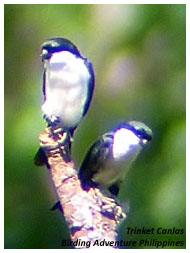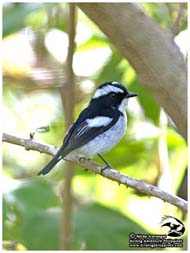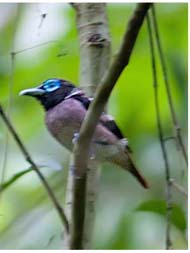| This is our main tour for 2010. Please check out our custom tours page for more flexible schedules. |
THE PHILIPPINES 2010 Day 1: Arrival at Manila International Airport
and will be picked up and transferred to hotel for overnight stay.
Day 4: We drive early morning north of Luzon to Banaue, Mountain Province. Along the way to Banaue, we will have a quick stop at Candaba Marsh, Pampanga to look for the endemic Philippine Duck and other waterbirds such as rails, bitterns and waders. This site is one of the Philippines’ best sites for migratory birds. We continue on to Banaue arriving late in the afternoon. We will be staying in Banaue Hotel for three nights.
Day 8: Today we spend all day birding around the former US Naval Base. There are great varieties of more widespread endemics and unique species in the area. The specialties we would be searching for are the Green Racquet-tail, Rufous Coucal, Blackish Cuckooshrike, White-lored Oriole and with lots of luck – the endemic White-fronted Tit. Day 9: We will have an early morning birding and drive to Manila in the afternoon for an overnight stay. Day 10: Morning flight from Manila to Puerto Princesa, Palawan. This island southwest of Luzon has several island endemics and other birds that are very similar to those from mainland Asia. Upon arrival, we will visit nearby beaches for the rare Chinese Egret and other wintering shorebirds. We then drive to Sabang, stopping at some sites in search of Palawan endemics. Later in the afternoon, we search for Palawan Scops Owl and Javan Frogmouth. We stay at Last Frontier Resort for 3 nights. Day 11-12: We visit the pristine forests of St. Paul’s National Park, home of the world famous underground river. This protected area is a UNESCO World Heritage site and is considered to be the longest navigable river tunnel in the world. We should find most of the island’s endemics in the area. Some individuals will require work, like the skulking Falcated Ground-Babbler, the shy Palawan Blue Flycatcher and the dazzling Palawan Peacock-Pheasant. Day 13: After a final morning birding, we return to Puerto Princesa for overnight stay. Day 14: Today we visit Balsahan Trail in Iwahig. This site is excellent for two endemic species, the Melodious Tree Babbler and Palawan Flycatcher that is not present in St. Paul’s. Before midday, we will drive to Narra, a town south of the Palawan capital, Puerto Princesa which is the take-off point for Rasa Island. Late in the afternoon we will visit Rasa Island. This island is the last stronghold of the critically endangered Philippine Cockatoo. Return to Narra and night at La Vista. Day 15: Early drive to Puerto Princesa City. We stop en route if we still need to search for the Palawan Flycatcher. Fly to Manila then connect to Bacolod, Negros Occidental to start the Visayan leg of our tour. We will spend the night at L’ Fisher Hotel. Day 16: This morning we take a short drive to the lower slopes of Mt. Canlaon. This is considered as the most active volcano in the Central Philippines. Mt. Canlaon has an elevation of 2435 m and is home to some of the best fauna and flora in the Panay / Negros region. We will be hiking up to 900 meters above sea level in search for Visayan Hornbill, White-winged Cuckooshrike, Flame-templed Babbler and White-vented whistler. We will also look for Visayan Flowerpecker at Mambucal. Return to L’ Fisher hotel. Day 17: We take an early morning flight from Bacolod to Cebu. Upon arrival, we drive to the Cebu port and take a Supercat ferry to Tagbilaran City, Bohol. This small island north of Mindanao is famous for wonderful dive spots, dolphin and whale-watching, and its white-sandy beaches and crystal clear waters. First stop is the Chocolate Hills Hotel, where we will stay for two nights. The Chocolate Hills is an unusual geological formation that is composed of around 1,268 perfectly cone-shaped hills of about the same size, spread over an area of more than 50 square kilometres (20 sq mi). They are covered in green grass that turns brown during the dry season, hence the name. In the late afternoon, we will visit nearby Rajah Sikatuna National Park (RSNP) to search for Philippine Frogmouth and other nocturnal birds. Day 18: We will have a full day birding at RSNP in search for Yellow-breasted Tailorbird, Visayan Broadbill (with lots of luck), Steere’s (Azure-breasted) Pitta, and Rufous-lored and Silvery Kingfishers. Day 19: Final morning birding at RSNP. Drive to Tagbilaran City and take the Supercat ferry back to Cebu. Overnight at Cebu. Day 20: Full day birding in Tabunan, Cebu. This site contains one of the last remaining remnants of primary forest in Cebu. Today will be searching for the island’s specialties, the Cebu Black Shama and with lots of luck the rare and rediscovered Cebu Flowerpecker. Return to hotel in the late afternoon. Day 21: Early morning departure for Davao to start the tour’s Mindanao leg. Drive to Bislig, Surigao and check-in at Paper Country Inn (PCI). We will visit Bislig Airport late in the afternoon to look for Philippine Duck, Wandering Whistling Duck and Australasian Grass Owl. Spend the night at PCI. Day 22-24: We will have three full days birding in PICOP in search of Mindanao lowland endemics. Though the forest is rapidly disappearing due to illegal logging, PICOP still holds several Mindanao lowland specialties such as Writhed, Rufous and Mindanao Hornbills, Blue-capped and Silvery Kingfishers, Black-faced Coucal, Red-bellied and Steere’s (Azure-breasted) Pitta, Celestial and Short-crested Monarchs. The few remaining patches of forests also host several species of the doves and pigeons such as Black-chinned Fruit-doves, Amethyst Brown-dove and other imperial pigeons. Day 25: We’ll have a break from birding and take a long drive to Cagayan de Oro. Spend the night at Harbor Lights Hotel. Day 26: This morning, we take a short drive to Dalwangan, Damitan Village, Bukidnon and take a hike to the Eagle Camp, rustic accommodations situated at the foothills of Mt. Kitanglad. This will be our home base for the next three nights. Before nightfall, we look around the camp grounds for the recently-described Bukidnon Woodcock, Philippine Frogmouth, and Mindanao and Giant Scops-Owls. Day 27-28: We will have two full days birding in search for the Great Philippine Eagle and other Mindanao montane endemics. We will be looking for Apo Myna, Cinnamon Ibon, Grey-hooded and Apo Sunbirds, Red-eared Parrotfinch, and White-cheeked Bullfinch. Day 29: Early morning birding to look for other species we might have missed. We will then trek back to Dalwangan and then drive back to Cagayan de Oro City. Fly Cagayan de Oro to Manila. Spend the night in Manila. Day 30: End of tour. |
||
 |
||
Copyright 2008. Birding Adventure Philippines. |
|
 |
Spotted Wood Kingfisher |
© Arnel Telesforo / BAP |
 |
Philippine Falconet |
© Trinket Canlas / BAP |
 |
Palawan Peacock
Pheasant |
© Nicky Icarangal / BAP |
 |
Ruddy Kingfisher |
© Nicky Icarangal / BAP |
 |
Little Pied Flycatcher |
© Nicky Icarangal / BAP |
 |
Blue-capped Wood
Kingfisher |
© Nicky Icarangal / BAP |
 |
Wattled Broadbill |
© Nicky Icarangal / BAP |
 |
Apo Myna |
© Nicky Icarangal / BAP |
 |
Silvery Kingfisher |
© Nicky Icarangal / BAP |








